#ancient math
Explore tagged Tumblr posts
Text
You ever pick an interest so niche you run out of YouTube videos?
#mandelbrot set#ancient math#I love you Benoit Mandelbrot#numberphile#veritiserum#Vsauce#Micheal please post more I need you#this is a really dark time for me
2 notes
·
View notes
Text
Regulus did NOT get the math autism
#i wanted tina to be remus at first but i couldn’t find enough good scenes of my remus fc so i pivoted#we live and we move on#i do hc that sirius is really really good at math and science and shit#meanwhile math problems feel like nails and needles being stabbed into the brain for regulus#his ass is not rain man#he got the gothic literature and history autism and sports autism#marauders#marauders fandom#marauders era#hp marauders#marauders headcanon#sirius black#james potter#peter pettigrew#marlene mckinnon#regulus black#regulus arcturus black#sirius orion black#james fleamont potter#dead gay wizards#harry potter#the black brothers#prongsfoot#padtail#jegulus#blackinnon#the most ancient and noble house of black#silly posting#bobs burgers#joke edit
276 notes
·
View notes
Text

When swimming through water, the snake leaves traces in the form of wavy circles, which exactly correspond to the dynamics of the shape of prime numbers.
A prime number is a natural number greater than 1 that has no positive factors other than 1 and itself. Prime numbers are specific numbers.
Don Zagier, a distinguished expert, said: “Looking at these figures, one feels the presence of one of the inexplicable mysteries of creation.
The images you see here are created using circles with diameters of successive primes, superimposed on each other and repeated from a common source. For each natural number "n" we draw a periodic curve from the origin intersecting the "x" axis in "n" and its multiples. Prime numbers are those that are intersected by just two curves: the prime number itself and one.
This is a simple method of constructing prime numbers using geometry.
#mathematics#consciousness#light#ascension#energy#alchemy#godhood#ancient#magic#matrix#simulated universe#simulated reality#phi#snake#patterns#holographic#holographic universe#simulation theory#waves#math#sacred geometry#golden ratio#fibonacci sequence#spiral#fibonacci spiral
353 notes
·
View notes
Text

1600’s Persia
#vintage#old#objects#persian#old art#esoteric#old charts#math#mathematics#museum#curators#aesthetic#Arabic#ancient persia#antique#rosieandthemoon#whimsicore#esoteric art#esoteric aesthetic#mystical#mystic#archive
94 notes
·
View notes
Text
Okay but what if my maths teacher is secretly Athena and I say ‘I’m so good at maths I’m the best at it ever’ and she’s like ‘are you sure?’ And I say ‘yeah’ and then she just says ‘she is come’ and transforms into Athena and then we have a maths test and I get too cocky so she turns my into a simultaneous equation.
569 notes
·
View notes
Text
The current (2024-7-23) first-link chain on Wikipedia containing mathematics goes
Mathematics -> Theory -> Reason -> Logic -> Logical reasoning -> Logical consequence -> Concept -> Abstraction -> Rule of inference -> Philosophy of logic -> Philosophy -> Existence -> Reality -> Universe -> Space -> Three-dimensional space -> Geometry -> Mathematics
and I think that's delightful.
#math#technically Mathematics links to Theory - Mathematical#and in that section the first link goes to Set Theory#which with the same rules lands you in a two-page loop Mathematical logic < - > Logic - Formal logic#also this is taking the rule of first link in the article body#so no etymological parentheticals#otherwise you'd veer off into Ancient Greek#(which incidentally still leads to Reason)
234 notes
·
View notes
Text

Simplified version of the Spartan Royal Family! From King Lacedaemon and Queen Sparta to Penelope!
#its actually 86% immortal I'm just bad at maths#Penelope is holding onto mortality like Odysseus was with that windbag#Zeus is her ancestor four times over#this is a streamlined clean version#there's an extremely messy draft in my files#hycainth and daphne are Cynortes' siblings!#penelope#penelope of sparta#penelope of ithaca#ancient sparta#spartan royal family#odysseus#epic the musical#the iliad#the odyssey#mycenean greece#ancient greek mythology#greek mythology#tagamemnon
80 notes
·
View notes
Text
ℋow I became the ℱirst 𝒫riestess of 𝒪lympus ✶ 𝒜NCIENT 𝒢REECE 𝒟R




Eirene Ivanthe Kallistrate was born on 4th day of the Silk Snows season (basically december) in 1199 B.C. She was a child of fortune with a definite purpose in life. She is the middle daughter of the very prominent Kallistrate family. Her mother is a well-known craftswoman, and her father traded vigorously while also leading a business. She has two older brothers, a protective and loving older sister, and three younger sisters who all looked up to her.
Eirene was always fascinated by the wisdom and discipline of Athena. While her peers dreamt of future alliances through politics and marriages, Eirene spent her time at the goddess’s temple. There, she devoted herself into studying philosophy, warfare, and the divine arts. People often said that Eirene was sharp minded and warm hearted which made her a great individual.

One fateful evening, the Oracle of Delphi delivered a prophecy that would change the course of her history.
— A mortal shall walk the path of the divine, uncovering secrets lost to time. She shall bind the goddesses together and, in doing so, bind herself to them. Through her hands, Olympus shall remember what it has forgotten —
Whispers spread through Eirene’s village, and all signs pointed to her. But, before she could embark on the journey, a boy named Euryochus boldly declared himself the chosen one and set out to fulfill the prophecy. Unwilling to let another take what felt like her destiny, Eirene set off alone and unprepared, but determined.
Her journey led her across the Aegean Sea, where she braved four islands, each guarding a crucial piece of the mystery. During her trials, each challenge she overcame became a stepping stone for the next. She battled a monster on Phyrra, and managed to break off one of its razor sharp nails, unknowingly gaining a tool that would help her later. On Naxos, as she struggled to unearth a hidden flower buried deep within the islands rocky soil, the monsters nail became her tool, allowing her to dig with precision. When she retrieved the flower, its petals shimmered with divine energy, and she discovered that by pressing them against her lips, she could breathe underwater. This gift proved invaluable when she reached Samos, where she had to dive beneath the waves to claim an ancient key resting in the sunken ruins. Finally she reached an island, unlike any other—so tiny it was just a little chunk of land, a place that didn't appear in maps. Yet, as she set foot on its shores, she felt its significance in every breath of the wind.

Euryochus had arrived first. In the center of the island, half buried in the earth, sat a small and ornate music box. Impatient, Euryochus attempted to break it open, but Eirene stopped him just in time. Instead, she took the key she had fought so hard to obtain and turned it in the delicate lock.
A haunting melody filled the air. The ground beneath them trembled, the waves surged outward, and before their eyes, the island itself began to rise. What was once a speck of land transformed into something far greater. Marble columns of great heights rose out of the depths, halls of white stone that stretched up towards the heavens, and an unblemished temple stood tall in the morning light.
The sky parted, and heavens light filled the temple steps. Down from the gold light descended all the goddesses: Hera, Demeter, Hestia, Aphrodite, Artemis, Hebe, Iris, Athena and more. Their eyes beheld Eirenes, and in them she read recognition. She was the one they had waited for, the mortal girl who had proven herself worthy.
But when their gaze fell on Euryochus, their reverence became contempt. Such a sacred place was not for people like him. They exiled him from the island by one command, sending him back to the world of mortals, his presence forgotten from their sacred soil.

They asked of what name Eirene would name this new born land. She did not hesitate, and said Thelyseion, in honor of her sweet sister Thelyomesse and her favorite cat Seian. The goddesses named her temple blessed, calling it Echidion, in honor of her brothers Echorogis and Diomidis.
The goddesses all had gifts to share with Eirenes newfound island. Athena bestowed her an order of owls that would protect the island at night, and olive trees, their fruit providing nourishment and their oil being used for countless purposes. Demeter blessed the earth itself, providing fertile soil and seeds. Aphrodite endowed upon the island apple trees bearing golden apples, and scattered seashells along the beach to attract water nymphs to the islands aid. Hera gave a herd of cattle for food and golden crowns, which later would be melted down to provide the islands currency. Hestia made a great fire that would burn eternally and never die out in the middle of the island. Artemis gave bows and arrows so that Eirene and her people could defend themselves against whoever would attempt to invade their sacred land. Hebe gave a fountain of pure, never failing water, with a pitcher of gold, so that no soul on the island would ever learn how to thirst, and numerous other gifts from other goddesses.
In that moment, Eirene transcended mortality, becoming the First Priestess of Olympus, the bridge between gods and humankind.
ⓘ solarlyls


credits to @sweetmelodygraphics , @strangergraphics & @anitalenia for the gorgeous golden dividers !!
also comment if youd like to be added to my taglist <3
#shifting trend#shift#shifting community#shiftblr#shiftingrealities#shifting blog#shifting consciousness#reality shifting#shifters#shifting#shifting antis dni#shifting motivation#shifting diary#dr ideas#drself#ancient greece dr#ancient greece#the only reason i made this dr is because of epic the musical…#half of this was written at 3 in the morning the other half in my math classes apologies.. if its all over the place#ⓘ lylias dr infos
65 notes
·
View notes
Text

75 notes
·
View notes
Text
April 14, Xi'an, China, Shaanxi History Museum, Qin and Han Dynasties Branch (Part 3 – Innovations and Philosophies):
(Edit: sorry this post came out so late, I got hit by the truck named life and had to get some rest, and this post in itself took some effort to research. But anyway it's finally up, please enjoy!)
A little background first, because this naming might lead to some confusions.....when you see location adjectives like "eastern", "western", "northern", "southern" added to the front of Zhou dynasty, Han dynasty, Song dynasty, and Jin/晋 dynasty, it just means the location of the capital city has changed. For example Han dynasty had its capital at Chang'an (Xi'an today) in the beginning, but after the very brief but not officially recognized "Xin dynasty" (9 - 23 AD; not officially recognized in traditional Chinese historiography, it's usually seen as a part of Han dynasty), Luoyang became the new capital. Because Chang'an is geographically to the west of Luoyang, the Han dynasty pre-Xin is called Western Han dynasty (202 BC - 8 AD), and the Han dynasty post-Xin is called Eastern Han dynasty (25 - 220 AD). As you can see here, in these cases this sort of adjective is simply used to indicate different time periods in the same dynasty.
Model of a dragonbone water lift/龙骨水车, Eastern Han dynasty. This is mainly used to push water up to higher elevations for the purpose of irrigation:
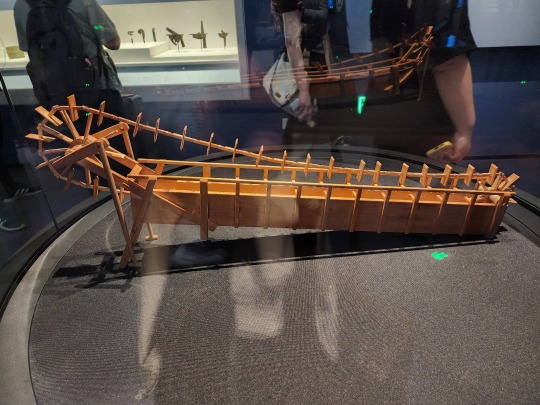
Model of a water-powered bellows/冶铁水排, Eastern Han dynasty. Just as the name implies, as flowing water pushes the water wheel around, the parts connected to the axle will pull and push on the bellows alternately, delivering more air to the furnace for the purpose of casting iron.

The Nine Chapters on the Mathematical Art/《九章算术》, Fangcheng/方程 chapter. It’s a compilation of the work of many scholars from 10 th century BC until 2 nd century AD, and while the earliest authors are unknown, it has been edited and supplemented by known scholars during Western Han dynasty (also when the final version of this book was compiled), then commented on by scholars during Three Kingdoms period (Kingdom of Wei) and Tang dynasty. The final version contains 246 example problems and solutions that focus on practical applications, for example measuring land, surveying land, construction, trading, and distributing taxes. This focus on practicality is because it has been used as a textbook to train civil servants. Note that during Han dynasty, fangcheng means the method of solving systems of linear equations; today, fangcheng simply means equation. For anyone who wants to know a little more about this book and math in ancient China, here’s an article about it. (link goes to pdf)

Diagram of a circle in a right triangle (called “勾股容圆” in Chinese), from the book Ceyuan Haijing/《测圆海镜》 by Yuan-era mathematician Li Ye/李冶 (his name was originally Li Zhi/李治) in 1248. Note that Pythagorean Theorem was known by the name Gougu Theorem/勾股定理 in ancient China, where gou/勾 and gu/股 mean the shorter and longer legs of the right triangle respectively, and the hypotenuse is named xian/弦 (unlike what the above linked article suggests, this naming has more to do with the ancient Chinese percussion instrument qing/磬, which is shaped similar to a right triangle). Gougu Theorem was recorded in the ancient Chinese mathematical work Zhoubi Suanjing/《周髀算经》, and the name Gougu Theorem is still used in China today.

Diagram of the proof for Gougu Theorem in Zhoubi Suanjing. The sentence on the left translates to "gou (shorter leg) squared and gu (longer leg) squared makes up xian (hypotenuse) squared", which is basically the equation a² + b² = c². Note that the character for "squared" here (mi/幂) means "power" today.

This is a diagram of Zhang Heng’s seismoscope, called houfeng didong yi/候风地动仪 (lit. “instrument that measures the winds and the movements of the earth”). It was invented during Eastern Han dynasty, but no artifact of houfeng didong yi has been discovered yet, this is presumably due to constant wars at the end of Eastern Han dynasty. All models and diagrams that exist right now are what historians and seismologists think it should look like based on descriptions from Eastern Han dynasty. This diagram is based on the most popular model by Wang Zhenduo that has an inverted column at the center, but this model has been widely criticized for its ability to actually detect earthquakes. A newer model that came out in 2005 with a swinging column pendulum in the center has shown the ability to detect earthquakes, but has yet to demonstrate ability to reliably detect the direction where the waves originate, and is also inconsistent with the descriptions recorded in ancient texts. What houfeng didong yi really looks like and how it really works remains a mystery.
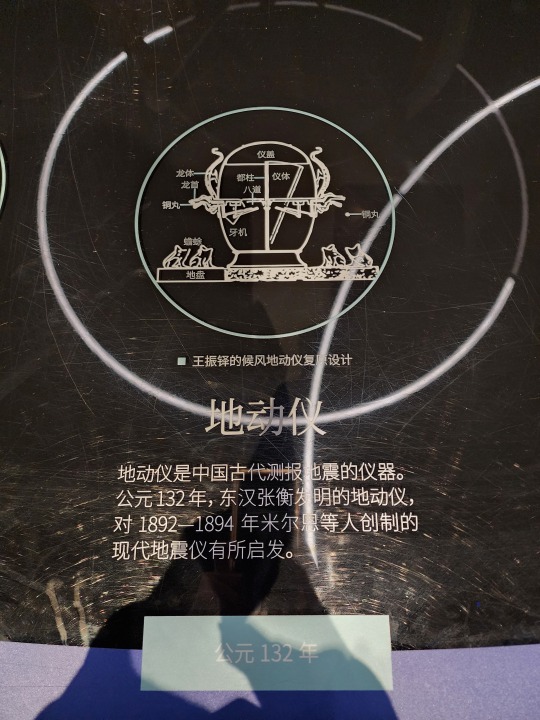
Xin dynasty bronze calipers, the earliest sliding caliper found as of now (not the earliest caliper btw). This diagram is the line drawing of the actual artifact (right).


Ancient Chinese "Jacquard" loom (called 提花机 or simply 花机 in Chinese, lit. "raise pattern machine"), which first appeared no later than 1st century BC. The illustration here is from the Ming-era (1368 - 1644) encyclopedia Tiangong Kaiwu/《天工开物》. Basically it's a giant loom operated by two people, the person below is the weaver, and the person sitting atop is the one who controls which warp threads should be lifted at what time (all already determined at the designing stage before any weaving begins), which creates patterns woven into the fabric. Here is a video that briefly shows how this type of loom works (start from around 1:00). For Hanfu lovers, this is how zhuanghua/妆花 fabric used to be woven, and how traditional silk fabrics like yunjin/云锦 continue to be woven. Because it is so labor intensive, real jacquard silk brocade woven this way are extremely expensive, so the vast majority of zhuanghua hanfu on the market are made from machine woven synthetic materials.

Chinese purple is a synthetic pigment with the chemical formula BaCuSi2O6. There's also a Chinese blue pigment. If anyone is interested in the chemistry of these two compounds, here's a paper on the topic. (link goes to pdf)

A list of common colors used in Qin and Han dynasties and the pigments involved. White pigment comes from chalk, lead compounds, and powdered sea shells; green pigment comes from malachite mineral; blue pigment usually comes from azurite mineral; black comes from pine soot and graphite; red comes from cinnabar; ochre comes from hematite; and yellow comes from realgar and orpiment minerals.

Also here are names of different colors and shades during Han dynasty. It's worth noting that qing/青 can mean green (ex: 青草, "green grass"), blue (ex: 青天, "blue sky"), any shade between green and blue, or even black (ex: 青丝, "black hair") in ancient Chinese depending on the context. Today 青 can mean green, blue, and everything in between.

Western Han-era bronze lamp shaped like a goose holding a fish in its beak. This lamp is interesting as the whole thing is hollow, so the smoke from the fire in the lamp (the fish shaped part) will go up into the neck of the goose, then go down into the body of the goose where there's water to catch the smoke, this way the smoke will not be released to the surrounding environment. There are also other lamps from around the same time designed like this, for example the famous gilt bronze lamp that's shaped like a kneeling person holding a lamp.


Part of a Qin-era (?) clay drainage pipe system:

A list of canals that was dug during Warring States period, Qin dynasty, and pre-Emperor Wu of Han Han dynasty (475 - 141 BC). Their purposes vary from transportation to irrigation. The name of the first canal on the list, Hong Gou/鸿沟, has already become a word in Chinese language, a metaphor for a clear separation that cannot be crossed (ex: 不可逾越的鸿沟, meaning "a gulf that cannot be crossed").

Han-era wooden boat. This boat is special in that its construction has clear inspirations from the ancient Romans, another indication of the amount of information exchange that took place along the Silk Road:

A model that shows how the Great Wall was constructed in Qin dynasty. Laborers would use bamboo to construct a scaffold (bamboo scaffolding is still used in construction today btw, though it's being gradually phased out) so people and materials (stone bricks and dirt) can get up onto the wall. Then the dirt in the middle of the wall would be compressed into rammed earth, called hangtu/夯土. A layer of stone bricks may be added to the outside of the hangtu wall to protect it from the elements. This was also the method of construction for many city walls in ancient China.

A list of the schools of thought that existed during Warring States period, their most influential figures, their scholars, and their most famous works. These include Confucianism (called Ru Jia/儒家 in Chinese; usually the suffix "家" at the end denotes a school of thought, not a religion; the suffix "教" is that one that denotes a religion), Daoism/道家, Legalism (Fa Jia/法家), Mohism/墨家, etc.

The "Five Classics" (五经) in the "Four Books and Five Classics" (四书五经) associated with the Confucian tradition, they are Shijing/《诗经》 (Classic of Poetry), Yijing/《易经》 (also known as I Ching), Shangshu/《尚书》 (Classic of History), Liji/《礼记》 (Book of Rites), and Chunqiu/《春秋》 (Spring and Autumn Annals). The "Four Books" (四书) are Daxue/《大学》 (Great Learning), Zhongyong/《中庸》 (Doctrine of the Mean), Lunyu/《论语》 (Analects), and Mengzi/《孟子》 (known as Mencius).

And finally the souvenir shop! Here's a Chinese chess (xiangqi/象棋) set where the pieces are fashioned like Western chess, in that they actually look like the things they are supposed to represent, compared to traditional Chinese chess pieces where each one is just a round wooden piece with the Chinese character for the piece on top:

A blind box set of small figurines that are supposed to mimic Shang and Zhou era animal-shaped bronze vessels. Fun fact, in Shang dynasty people revered owls, and there was a female general named Fu Hao/妇好 who was buried with an owl-shaped bronze vessel, so that's why this set has three different owls (top left, top right, and middle). I got one of these owls (I love birds so yay!)


And that concludes the museums I visited while in Xi'an!
#2024 china#xi'an#china#shaanxi history museum qin and han dynasties branch#chinese history#chinese culture#chinese language#qin dynasty#han dynasty#warring states period#chinese philosophy#ancient technology#math history#history#culture#language
96 notes
·
View notes
Text
67 notes
·
View notes
Text
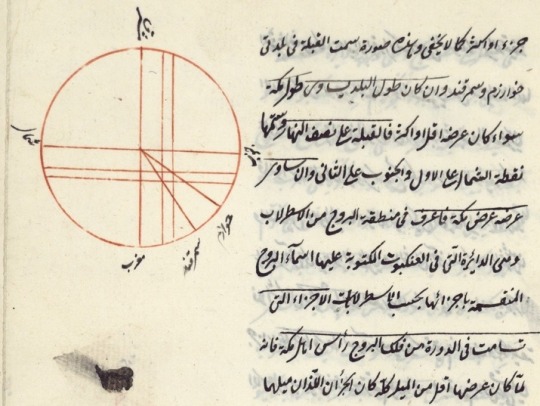
The Founders☪️⭕️
By:
Mahmoud al-Jaghmini
#islamic golden age#circle#islamic#ancient texts#ancient writing#arabic#astronomy#ancient astronomy#astronomers#mathematical#mathematics#mathblr#mathcore#math
20 notes
·
View notes
Text

Woodcut from "One Hundred and Sixty Articles Against the Mathematicians and Philosophers of This Tempest" by Giordano Bruno
#Giordano Bruno#sacred geometry#serpent#geometry#simulation theory#simulated reality#simulated universe#holographic universe#consciousness#light#mathematics#science#philosophy#energy#ascension#magic#godhood#ancient#enlightenment#books#flower of life#technology#age of aquarius#alchemy#math#art#patterns
111 notes
·
View notes
Text
Castlevania Nocturne S2 - Drolta's Timeline, wtf Netflix?
Uh oh. I think the writers messed up. Drolta tells Erzsebet in 2x7:
"I wandered the Earth for a thousand years seeking a vessel. And then I found you, the perfect human monster. For nearly 200 more, I prepared you for your destiny."
That means Drolta's been a vamp for approx 1200 years. But the show takes place in 1793 (King Louis 16th is guillotined in 2x3). And we KNOW Drolta was turned into a vamp in 1199.
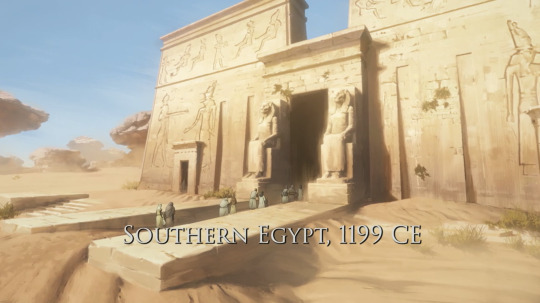
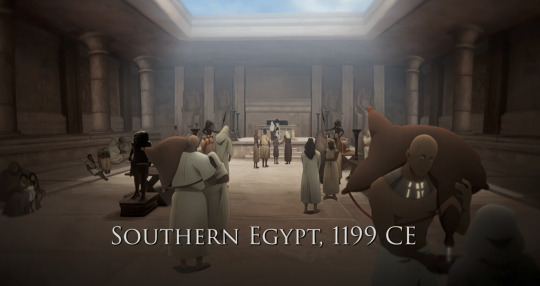
Meaning Drolta's only been a vamp for 594 years. 🤨
But check this: 1793 - 1200 = 593. 👀 As in, Drolta's speech to Erzsebet implies that she was turned into a vamp in 593 AD--when Egypt was still in the Roman Empire, right before the Sasanians invaded, and conquered Egypt in 618 AD.
And Drolta's temple was attacked by obvs foreign vampires....
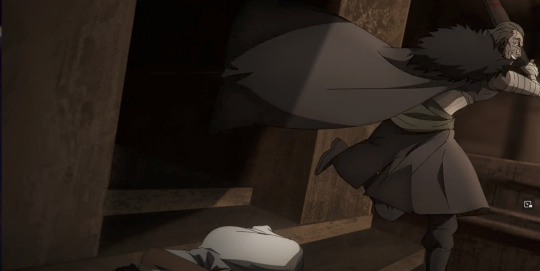

And this dude's got a vaguely familiar looking helmet....
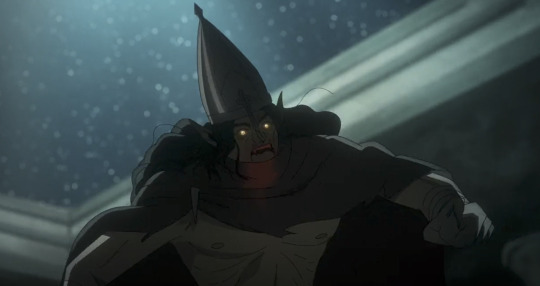


So now I'm wondering if there wasn't some HUGE discrepancy somewhere, where Drolta was originally supposed to be oooold AF, who was human way back in Roman Late Antiquity, when Egypt was still pagan (more or less; Christianity was on the rise); before the Sasanians attacked & she became a vampire.
And for whatever reason, that timeline was pushed down to the Middle Ages & the Ayyubid Sultanate instead (when Egypt was Muslim and the pagan traditions were long buried).
So which one is it, Netflix? Is Drolta 1200+ years old, or 500+? 🤔
To be more precise, Drolta said this in 2x5:
Her power strengthened by tasting your holy blood. Drop by drop. Sip by sip. Year by year. For 175 cycles of the sun. She will not burn. And you will walk the earth again.
So we can actually knock off 25 years from 1200, and say she's 1175 years old, going by what she said in 2x7. Meaning she would've been turned in 618, the EXACT year that the Sasanians invaded Egypt.
38 notes
·
View notes
Text









https://www.facebook.com/61573720163498
#memes#viral#funny#humor#kittens#cats#sores#dogs#taxidermy#peekaboo#assemblage#dragonfly#witch#yard#kirby#financial district#1990s#ancient history#science#math#formulas#eat the rich#protest#water cannon#conservative#christian
21 notes
·
View notes
Text
my favorite bit about miraculous (season 6) so far is learning that adrien agreste studies ancient greek as an elective. my super intelligent nerdy son. 🥺
#adrien agreste#miraculous ladybug#miraculous#this piece of information is vital to me as someone with a degree in classics who studied ancient latin for many years#reaffirms how damn intelligent this boy is and also how he's such a dork and why i relate to him so much#ancient greek is often considered way more complicated than latin and there are nearly three times as any forms to memorize#also it's very closely related to the sciences and specifically math so the people who headcanon adrien as a physics nerd also win#ml spoilers#ml s6 spoilers
29 notes
·
View notes